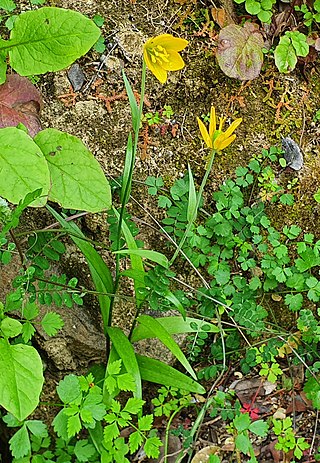
Hygrocybe is a genus of agarics in the family Hygrophoraceae. Called waxcaps in English, basidiocarps are often brightly coloured and have dry to waxy caps, white spores, and smooth, ringless stems. In Europe they are characteristic of old, unimproved grasslands which are a declining habitat, making many Hygrocybe species of conservation concern. Four of these waxcap-grassland species, Hygrocybe citrinovirens, H. punicea, H. spadicea, and H. splendidissima, are assessed as globally "vulnerable" on the IUCN Red List of Threatened Species. Elsewhere waxcaps are more typically found in woodlands. Most are ground-dwelling and all are believed to be biotrophs. Around 150 species are recognized worldwide. Fruit bodies of several Hygrocybe species are considered edible and are sometimes offered for sale in local markets.

Beddomeia hallae, also known as Buttons Rivulet hydrobiid snail, is a species of small freshwater snail that is endemic to Australia. The species is an aquatic operculate gastropod mollusk in the family Hydrobiidae. Beddomeia hallae belongs to the genus Beddomeia, which is the largest group in the family Hydrobiidae, consisting of 47 species. In the Threatened Species Protection Act 1995, this species is one of the 37 Beddomeia species listed as endangered, however, on the International Union for Conservation of Nature Red List, the species is listed as vulnerable. Found in Tasmania, in the streams of Buttons Rivulet and Castra Rivulet, Beddomeia hallae is sighted in its natural habitat amongst wood, leaves and under stones. Nonetheless, the Beddomeia species including Beddomeia hallae are geographically isolated, existing within restricted ranges.
Fonscochlea conica is a species of minute freshwater snails with an operculum, aquatic gastropod molluscs or micromolluscs in the family Hydrobiidae. This species is endemic to Australia.
Paludinella conica is a species of minute salt marsh snail with an operculum, an aquatic gastropod mollusk or micromollusk in the family Assimineidae. This species is found in Guam and the Northern Mariana Islands.
Phrantela annamurrayae is a species of minute freshwater snail with an operculum, an aquatic gastropod mollusc or micromollusc in the family Hydrobiidae. This species is endemic to Australia.
Phrantela is a genus of minute freshwater snails with an operculum, aquatic gastropod molluscs or micromolluscs in the family Hydrobiidae.
Phrantela kutikina is a species of minute freshwater snail with an operculum, an aquatic gastropod mollusc or micromollusc in the family Hydrobiidae. This species is endemic to Australia.
Phrantela pupiformis is a species of minute freshwater snail with an operculum, an aquatic gastropod mollusc or micromollusc in the family Hydrobiidae. This species is endemic to Australia.
Phrantela richardsoni is a species of minute freshwater snail with an operculum, an aquatic gastropod mollusc or micromollusc in the family Hydrobiidae. This species is endemic to Australia.
Phrantela umbilicata is a species of minute freshwater snail with an operculum, an aquatic gastropod mollusc or micromollusc in the family Hydrobiidae. This species is endemic to Australia.
The Kingman springsnail is a species of freshwater snail in the family Hydrobiidae, the mud snails. It is endemic to Mohave County, Arizona, in the United States.

Samoana conica is a species of tropical, air-breathing land snail, a terrestrial, pulmonate, gastropod mollusc in the family Partulidae. This species is endemic to American Samoa.
Annona conica is a species of plant in the Annonaceae family. It is endemic to Ecuador. Its natural habitats are subtropical or tropical dry forests and subtropical or tropical moist lowland forests. It is threatened by habitat loss. The maximum average height for a domesticated Annona Conica is around 300 cm and in the wild 500 cm.
Knema conica is a species of plant in the family Myristicaceae. It is endemic to Thailand.
Richetia conica is a species of flowering plant in the family Dipterocarpaceae. It is a small to medium-sized tree endemic to eastern Sumatra. It grows in the lowland rain forest and periodic swamp forest of Riau Province, below 500 meters elevation. It has been subject to habitat loss from conversion of its native forests to pulpwood and oil palm plantations, and now mostly survives in small protected areas. It is assessed as endangered by the IUCN.
Graecoanatolica conica is a species of freshwater snail, an aquatic gastropod mollusk in the family Hydrobiidae. The species is endemic to a spring between the Turkish villages of Çardak and Dazkırı.

Fritillaria conica is a species of flowering plant of the Liliaceae family native to South West Greece. More specifically, it is endemic to the Peloponnese.




